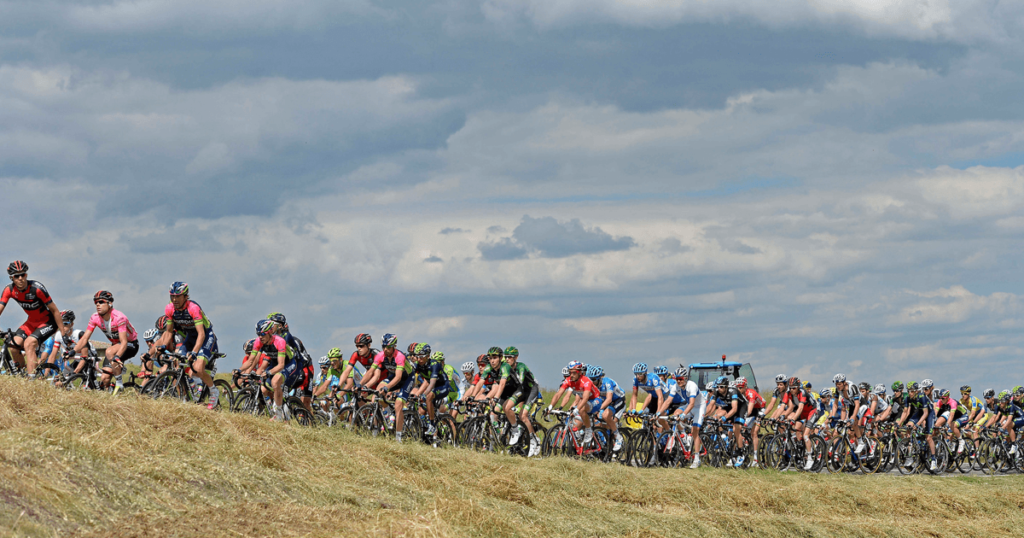The Beautiful Race
An excerpt from Colin O’Brien’s exploration of Italy’s greatest cycling event

With whiffs of warm weather, many of us feel inspired to lug our trusty, old bikes out of the garage and go for a springtime spin. Professional cyclists, though, would scoff—they’ve been training through the cold to prepare for the three big bike events of the summer, the Grand Tours. We know about the grueling weeks in July, when racers pedal through France for the crown prize of the Tour de France: the maillot jaune, or yellow jersey. Less than a month later, many of the same riders will also race in the brutal August heat during the Vuelta a España. But the season begins in May with the Giro d’Italia, when cyclists will rely on strength and spirit to traverse the countryside, up into the Dolomites and all the way down to the heel of Italy’s boot. Colin O’Brien’s new book, The Beautiful Race, chronicles the history of the event, which has taken place each year (except during world wars) for more than a century. “For the guts of a month every year, it ingrains itself into everyday life in a way that few other cultural phenomena can,” he writes. In this excerpt, the leading cyclists battle for the Giro’s maglia rosa—the winning pink jersey—during the 2005 Colle delle Finestre summit finish.
‘The hill of windows.’ A fitting name for one of Italy’s most visually stunning mountain passes, a road that offers postcard-like views at almost every turn, climbing from Meana di Susa, three quarters of an hour from the metropolitan buzz of downtown Turin, through a thick tangle of forest and tightly bound bends towards an untouched, elevated paradise, worlds away from the city below. First commissioned by Louis XIV in the eighteenth century, the Colle delle Finestre connects the Susa and Chisone valleys to the largest Alpine fortress in Europe, Forte di Fenestrelle. And though it’s one of the newest additions to the Giro d’Italia’s portfolio of theatrical climbs, it is already one of its most famous.
The former Giro director Carmine Castellano first stumbled upon the road in 1995 and immediately knew that it could be his legacy to the race, but it would take a decade before the Corsa Rosa finally scaled the Finestre’s 45 hairpins. The main problem facing Castellano had been the route’s horrible surface. It was, in his own words, ‘an impassable goat track’. But with the 2006 Turin Winter Olympics looming, the Piemonte regional government had money to spend promoting itself—and there were few better ways to do so than by unveiling a modern cycling classic as the 2005 Giro’s final mountain stage. The road was improved, but without losing the distinctive, sooty gravel that added to the challenge of an 18.5-kilometre climb that reaches an altitude of 2,178 metres with an average gradient of over nine per cent.
This was a climb to hark back to the Giro’s golden age, unpaved and irrationally difficult, a special end that echoed the great innovations of Vincenzo Torriani decades before, on the Stelvio and the Gavia. Better still, after 18 stages the fight for general classification was still precariously balanced between the leader, the 2002 Giro winner Paolo Savoldelli, one of the all-time great descenders, who was also sitting on a two-minute lead, and Gilberto Simoni, champion in 2001 and 2003 and by some margin the superior climber. A minute further back in the standings, Venezuela’s José Rujano and a young Danilo Di Luca were close enough to feature, too.
The route took the peloton over Sestriere first, and by the foothills of the Finestre, Savoldelli was struggling to keep up with Simoni, Di Luca and Rujano. The attacking trio were lighter and better suited to the mountains, and the Maglia Rosa often suffered from allergies. There was no way he could match the inhuman pace that Di Luca was setting. Simoni was the virtual race leader, but his rival tried to remain unfazed. It was up to the mountains to decide their fate.
Luck was on Savoldelli’s side. The young Colombian Mauricio Ardila, whose Giro had come undone several stages earlier, started to pull. Whether he did so out of pride or because his race director was an old friend of Savoldelli mattered little to the Maglia Rosa. He was gaining on the aggressors, just when Di Luca was pushing the limits of his implausible performance.
Simoni was still leading the provisional GC at the summit of the Finestre, but the impetus was with the man in pink, now descending, back doing what he did best, with the tiny Ardila glued firmly to his wheel. As the road rose for the final climb back up Sestriere, the gap fell. Di Luca was spat out the back leaving Simoni exposed, with only the work-shy Rujano for company. With 10 kilometres to go, the gap was one minute 37 seconds—with a 20-second bonus guaranteed to the winner. With eight kilometres to go, the gap was one minute 20, half a minute less than Simoni needed even if he took the stage. Then, with four to go, the cunning Rujano played his hand, attacking his breakaway partner with a dash to the finish to take a victory that was both cruel and brilliant. Simoni was 22 seconds behind, followed by a distant and destroyed Di Luca. It took Savoldelli one minute 53 seconds to cross the line, but he’d done enough. He still led by 28 seconds. The 2005 Giro d’Italia was his.
Excerpt of The Beautiful Race by Colin O’Brien. Published by Pegasus Books. Reprinted with permission. All other rights reserved. © Colin O’Brien

